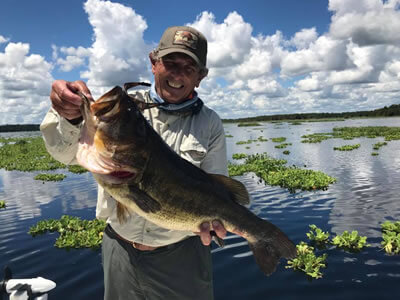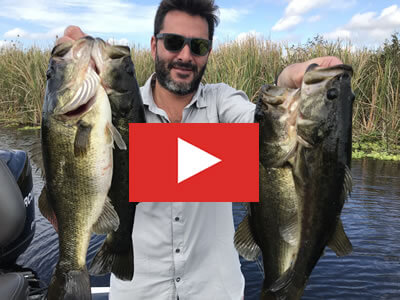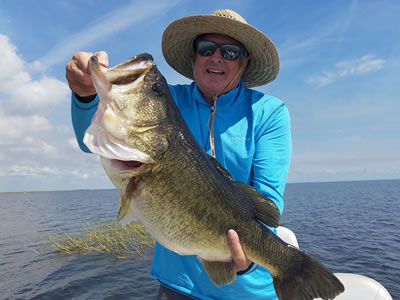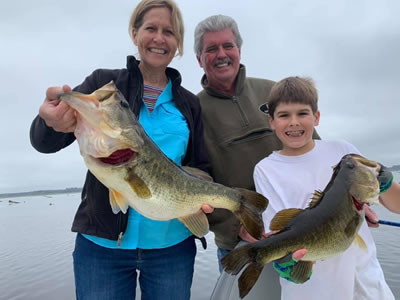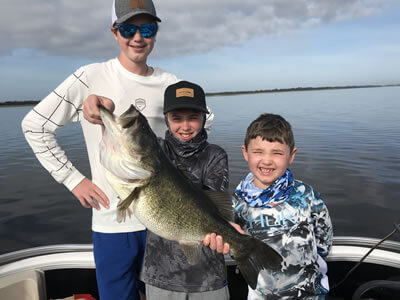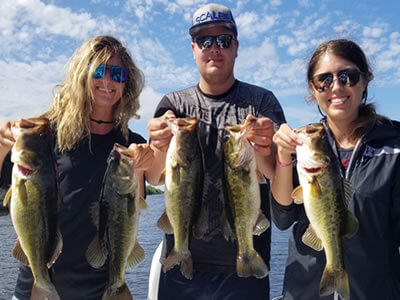Alligator Gar
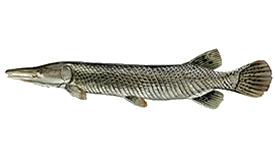
Alligator Gar-Common Names
Other Names: Gar, Garfish
Description:
They are one of the most distinctive freshwater fish species. Alligator gars are the largest of all gar species with a head that looks very much like an alligator’s. They can be distinguished from all other gars species by the two rows of teeth in the upper jaw, their short-broader snout, and their size when fully grown.
The body is long, slender, and olive greenish-brown color and sometimes blackish. Along the upper sides and back mainly darker, the belly is ordinally white or yellowish. The large black spots toward the rear and sides blend into the head with and align with the tail fin. The young the Gar, the lighter stripe and marking they have which include the well marked spots.
Feeding Habits – They mainly feed on fish but are known to eat ducks and other water birds.
Age and Growth – They are one of the monsters of fresh waters. They can reach lengths of up to 10 feet and weights of more than 200 pounds.
ABOUT ALLIGATOR GAR
Where Do Alligator Gar Live
These gars can live and hunt in both fresh and saltwater. They mostly live in slower-moving rivers, reservoirs, and brackish waters. Texas is king, followed by Mississippi, Oklahoma, Arkansas and Florida. Estuaries along the Gulf of Mexico for coast states are prime locations. They can also be found in saltwater, usually further out. The habitat of alligator gars varies by season. They prefer to reside in coves with no current off main rivers in the winter.
In Spring, they begin a journey to the river’s main channel, frequently returning to the cove. Later in Spring, they will finally begin their descent further away from the cove. They could go as far 250 miles north during these times. As example, in Florida the Escambia Bay during this time of the year is prime for big Gar but also travel as far north as Alabama. Each state has these migration location, you just need to find them and get the time correct.
How Big Can Big Gar Get
Alligator gars are one of the biggest freshwater fish in North America. The females are larger than males. The biggest alligator gars weigh up to 350 pounds and grow up to 10 feet long. However, the average adults are 4 to 6 feet in length and weigh 100 to 160 pounds.
Alligator Gar Teeth
Gars have relatively short, broad snouts with two rows of sharp teeth in the upper jaw; other gars only have one row of teeth. Alligator gars have about 80 teeth in total. Their teeth get replaced by new ones as they wear down. On average, an alligator gar goes through 2,000 to 3,000 teeth in a lifetime. They use their fang-like teeth to pierce and hold prey.
BIG GAR HABITS
What do Alligator Gar Eat
Alligator Gar are stalking, ambush predators who eat mostly fish along with birds, turtles, and other small mammals floating on the surface.
These gars are large and carnivorous, but most of their time is spent being passive and solitary. Alligator gar are not aggressive towards humans.
Alligator Gar Spawning
Alligator gar are slow matures; they are about ten years old before they start to spawn. Spawning time is April to June when the water temperatures are over 70 degrees Fahrenheit. Shallow, heavily vegetated areas are ideal locations for all gar spawns. During this time, gars typically congregate in large quantities. The females often spawn with several males at once. It takes only a couple of days for the eggs to hatch.
Alligator Gar Fishing
What to Use to Catch Alligator Gar
It’s possible to catch alligator gar on pretty much any setup. Alligator gars have been caught using live bait, cut bait, artificial lures, and fly.
Bait commonly used for alligator gar are carp, gizzard shad, smallmouth buffalo, and mullet. To decide which bait to use, it’s best to choose the one most common in the area you are fishing. For rivers and lakes, gizzard shad and carp are usually best.
One popular setup is common Grass carp fish as bait on a 5/0 or bigger hook, with an opening wide enough to enclose the bottom jaw. A braided solid line to a steel leader is used to fasten the hook. The Gar typically picks up bait near the bottom of the water and travels a reasonable distance before stopping to ingest it. A powerful hookset is crucial to penetrate the gar’s mouth after it takes the bait.
When removing the hook from an alligator gar’s mouth, anglers should wear cut-resistant gloves and use pliers. Be mindful of their sharp scales, stay clear of the powerful tail, and never stick your hands in the gar’s mouth.
How to catch Gar
Alligator gar are a challenge to catch because of their sharp teeth that can easily cut through lines and cautious feeding behaviors, especially in adults.
Gars won’t eat anything they can’t swallow. Their teeth are meant for trapping prey, not tearing it into chunks. They commonly hesitate before swallowing the bait, especially if anything feels out of place. They will drop the bait if they feel resistance of any kind.
Alligator Gar World Record
The alligator gar all-tackle world record was 279 pounds caught in Texas in 1951.
WHERE CAN YOU FISH FOR BIG GAR

GAR IN TEXAS

GAR IN FLORIDA

GAR IN OKLAHOMA

GAR IN ARKANSAS
MORE SPECIFICS ABOUT GAR
Fun Facts:
- Alligator Gar can eat prey up to 25% of their body length
- Average life span is 35 years and have a life span of 50 years
- World-record Alligator gar was over 8 feet long and declared weight was 327-pounds.
- Females can lay eggs and they hatch with in two days
Records:
- World: 327-pounds, in Mississippi
- All tackle record is in Texas in 1951: 279-pounds
- Florida: 132 pounds, caught in Yellow River in 2011
- Arkansas: 240-pounds, caught in the White river in 2004
Fishing Techniques:
- Light Tackle
- Heavy Tackle
- Live bait
- Fly Fishing
- Artificial Lures
- Night fishing
Fishing Equipment:
- Spinning Rods
- Baitcasting Rods
- Left & Right Handed
- Fly Rods (request only)
- Braid & Mono Line

